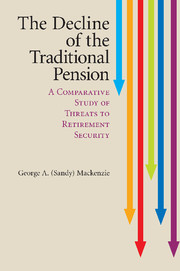Book contents
- Frontmatter
- Contents
- List of Tables
- List of Figures
- List of Boxes
- Acknowledgments
- Introduction
- PART ONE
- 1 The Development of Employer-Provided Pensions
- 2 The Economics of Employer-Provided Pension Plans
- 3 Issues in Funding and Investing
- 4 Current Regulatory Issues
- 5 Public-Sector Employer-Provided Pensions and Recent Innovations in the First Tier
- PART TWO
- Appendix 1 Ten Country Profiles
- Appendix 2 Mathematical Treatments and Derivations
- Glossary
- References
- Index
3 - Issues in Funding and Investing
Published online by Cambridge University Press: 05 June 2012
- Frontmatter
- Contents
- List of Tables
- List of Figures
- List of Boxes
- Acknowledgments
- Introduction
- PART ONE
- 1 The Development of Employer-Provided Pensions
- 2 The Economics of Employer-Provided Pension Plans
- 3 Issues in Funding and Investing
- 4 Current Regulatory Issues
- 5 Public-Sector Employer-Provided Pensions and Recent Innovations in the First Tier
- PART TWO
- Appendix 1 Ten Country Profiles
- Appendix 2 Mathematical Treatments and Derivations
- Glossary
- References
- Index
Summary
Four Issues in Funding
Introduction
Employer-provided pension plans – traditional, hybrid, or defined contribution – all have balance sheets, and the aim of plan funding (at least in the case of traditional and hybrid plans) is to ensure that a plan will always have enough assets to honor its pension promises. A successful funding strategy will prevent a shortfall, or at least an excessive shortfall, of plan assets from liabilities and will require that a plan's sponsor take steps to close any gap that emerges between liabilities and assets in an appropriately short period of time. As Whittington (2006) points out, the adoption of the balance-sheet method of pension fund accounting, which is a necessary but not a sufficient condition for adequate funding, is relatively recent. He dates it from the issue by the Financial Accounting Standards Board (FASB) of Statement No. 87 in 1985.
With the balance-sheet approach, the net cost that the plan incurs in a particular period is the increase in the plan's net liabilities. Net cost in period t (NCt) can be represented by the following expression [equation (3.1)]:
NCt = Lt-1 • rt + Bt + BPSt - At-1 • rt + EXADJt
The variable r stands again for the rate of interest, L stands for the stock of plan liabilities, B for benefits earned by plan members during the current period, BPS for the benefits earned from past service, A for assets, and EXADJ for what are called experience adjustments.
- Type
- Chapter
- Information
- The Decline of the Traditional PensionA Comparative Study of Threats to Retirement Security, pp. 65 - 93Publisher: Cambridge University PressPrint publication year: 2010



